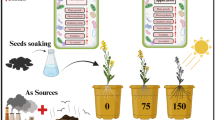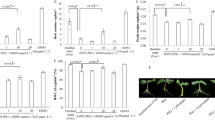Abstract
The goal of this study was to evaluate impacts of electromagnetic fields (EMF) on the membrane lipid peroxidation, anatomical alterations, antioxidant enzymes activities, total phenolic and flavonoid contents of Physalis alkekengi L. from Solanaceae family. In vitro germinated seeds were exposed with various intensities of EMF (0, 2, 4, 6 and 8 mT). Our results showed that EMF enhanced dry mass, root and shoot length, protein content, superoxide dismutase (SOD) and peroxidase (POX) enzymes activities, while decreased hydrogen peroxide (H2O2) level, lipid peroxidation (MDA) and catalase (CAT) activity as compared to the control. The maximum induction of seed germination (81.2%) was detected at 6 mT. Xylem number, phloem area and stele diameter increased up to 4 mT in P. alkekengi, and then decreased at higher intensities. Total phenolic and flavonoid also increased under different EMF intensities, and the optimum contents were observed at 4 (147.36 µg/g dry wt) and 6 mT (99.36 µg/g dry wt) for total phenolic and flavonoid, respectively. The results revealed that EMF pretreatment improved, secondary metabolites content and membrane stability via promoting antioxidant enzyme activity and reactive oxygen scavenging in P. alkekengi seedlings.





Similar content being viewed by others
REFERENCES
Ge, Y., Duan, Y., Fang, G., Zhang, Y., and Wang, S., Study on biological activities of Physalisalkekengi var. francheti polysaccharide, J. Sci. Food Agric., 2009, vol. 89, p. 1593.
Helvaci, S., Kökdil, G., Kawai, M., Duran, N., Duran, G., and Güvenç, A., Antimicrobial activity of the extracts and physalin D from Physalis alkekengi and evaluation of antioxidant potential of physalin D, Pharm. Biol., 2010, vol. 48, p. 142.
Zhu, F., Dai, C., Fu, Y., Loo, J.F.C., Xia, D., Gao, S.P., Ma, Z., and Chen, Z., Physalin A exerts anti-tumor activity in non-small cell lung cancer cell lines by suppressing JAK/STAT3 signaling, Oncotarget, 2016, vol. 7, p. 9462.
Hong, J.M., Kwon, O.K., Shin, I.S., Song, H.H., Shin, N.R., Jeon, C.M., Oh, S.R., Han, S.B., and Ahn, K.S., Anti-inflammatory activities of Physalis alkekengi var. franchetii extract through the inhibition of MMP-9 and AP-1 activation, Immunobiology, 2015, vol. 220, p. 1.
Gould, J.L., Magnetoreception, Curr. Biol., 2010, vol. 20, p. R431.
Shabrangi, A. and Majd, A., Comparing effects of electromagnetic fields (60 Hz) on seed germination and seedling development in monocotyledons and dicotyledons, Proc. Prog. Electromagn. Res. Symp., 2009, p. 704.
Asghar, T., Jamil, Y., Iqbal, M., and Abbas, M., Laser light and magnetic field stimulation effect on biochemical, enzymes activities and chlorophyll contents in soybean seeds and seedlings during early growth stages, J. Photochem. Photobiol., B, 2016, vol. 165, p. 283.
Azimian, F. and Roshandel, P., Magnetic field effects on total phenolic content and antioxidant activity in Artemisia sieberi under salinity, Ind. J. Plant. Physiol., 2015, vol. 120, p. 264.
Hassanpour, H. and Niknam, V., Establishment and assessment of cell suspension cultures of Matricaria chamomilla as a possible source of apigenin under static magnetic field, Plant Cell, Tissue Organ Cult., 2020, vol. 142, p. 583.
Murashige, T. and Skoog, F., A revised medium for rapid growth and bioassays with tobacco tissue cultures, J. Physiol. Plant., 1962, vol. 15, p. 473.
Mansourkhaki, M., Hassanpour, H., and Hekmati, M., Effect of static magnetic field on growth factors, antioxidant activity and anatomical responses of Silybum marianum seedlings, J. Plant. Proc. Funct., 2019, vol. 7, p. 10.
Noorbakhsh, N., Ghahraman, A., Attar, F., and Mahdigholi, K., Leaf anatomy of Artimisia (Asteraceae) in Iran and its taxonomic implications, Iran. J. Bot., 2008, vol. 14, p. 54.
Heath, R.L. and Packer, L., Photoperoxidation in isolated chloroplasts: I. kinetics and stoichiometry of fatty acid peroxidation, Arch. Biochem. Biophys., 1968, vol. 125, p. 189.
Velikova, V., Yordanov, I., and Edreva, A., Oxidative stress and some antioxidant systems in acid rain-treated bean plants: protective role of exogenous polyamines, Plant. Sci., 2000, vol. 151, p. 59.
Bradford, M.M., A rapid and sensitive method for the quantitation of microgram quantities of protein utilizing the principle of protein-dye binding, Anal. Biochem., 1967, vol. 72, p. 248.
Giannopolitis, C.N. and Ries, S.K., Superoxide dismutases: II. Purification and quantitative relationship with water-soluble protein in seedlings, J. Plant. Physiol., 1997, vol. 59, p. 315.
Aebi, H., Catalase in vitro, Methods Enzymol., 1984, vol. 105, p. 121.
Abeles, F.B. and Biles, C.L., Characterization of peroxidases in lignifying peach fruit endocarp, J. Plant. Physiol., 1991, vol. 95, p. 269.
Singleton, V.L. and Rosi, J.A., Colorimetry of total phenolics with phosphomolybdic–phosphotungstic acid reagents, Am. J. Enol. Vitric., 1965, vol. 16, p. 144.
Hatamnia, A.A., Abbaspour, N., and Darvishzadeh, R., Antioxidant activity and phenolic profile of different parts of bene (Pistacia atlantica subsp. kurdica) fruits. Food Chem., 2014, vol. 145, p. 306.
Baghel, L., Katria, S., and Guruprasad, K.N., Effect of static magnetic field pretreatment on growth, photosynthetic performance and yield of soybean under water stress, Bioelectromagnetics, 2017, vol. 37, p. 455.
Vashisth, A. and Nagarajan, S., Exposure of seeds to static magnetic field enhances germination and early growth characteristics in chick pea (Cicer arietinum L.), Bioelectromagnetics, 2008, vol. 29, p. 571.
Kozlowski, T.T., Responses of woody plants to flooding and salinity, Tree Physiol. Monogr., 1997, vol. 1, p. 1.
Selim, A.F.H. and El-Nady, M.F., Physio-anatomical responses of drought stressed tomato plants to magnetic field, Acta Astronaut., 2011, vol. 69, p. 387.
Apel, K. and Hirt, H., Reactive oxygen species: metabolism, oxidative stress, and signal transduction, Annu. Rev. Plant Biol., 2004, vol. 55, p. 373.
Blokhina, O., Virolainen, E., and Fagerstedt, K.V., Antioxidants, oxidative damage and oxygen deprivation stress: a review, Ann. Bot., 2003, vol. 91, p. 179.
Haghighat, N., Abdolmaleki, P., Ghanati, F., Behmanesh, M., and Payez, A., Modification of catalase and MAPK in Vicia faba cultivated in soil with high natural radioactivity and treated with a static magnetic field, J. Plant Physiol., 2014, vol. 5, p. 99.
Serdyukov, Y. and Novitskii, Y.I., Impact of weak permanent magnetic field on antioxidant enzyme activities in radish seedlings, Russ. J. Plant. Physiol., 2013, vol. 60, p. 69.
Bose, J., Rodrigo-Moreno, A., and Shabala, S., ROS homeostasis in halophytes in the context of salinity stress tolerance, J. Exp. Bot., 2014, vol. 65, p. 1241.
Wang, F., Zhu, H., Chen, D., Li, Z., Peng, R., and Yao, Q., A grape bHLH transcription factor gene, VvbHLH1, increases the accumulation of flavonoids and enhances salt and drought tolerance in transgenic Arabidopsis thaliana, Plant Cell, Tissue Organ Cult., 2016, vol. 125, p. 387.
Funding
This research was supported by Aerospace Research Institute, Tehran, Iran.
Author information
Authors and Affiliations
Corresponding author
Ethics declarations
Conflict of interests. The authors declare that they have no conflicts of interest.
Statement on the welfare of humans or animals. This article does not contain any studies involving animals performed by any of the authors.
Additional information
Abbreviations: EMF—electromagnetic fields; MDA—malondialdehyde; mT—milliTesla: SMF—static magnetic field; T—Tesla.
Rights and permissions
About this article
Cite this article
Hassanpour, H., Hassanpour, S. Promoting Impact of Electromagnetic Field on Antioxidant System and Performance of Vascular Tissues in Physalis alkekengi . Russ J Plant Physiol 68, 545–551 (2021). https://doi.org/10.1134/S1021443721030079
Received:
Revised:
Accepted:
Published:
Issue Date:
DOI: https://doi.org/10.1134/S1021443721030079




